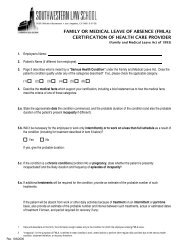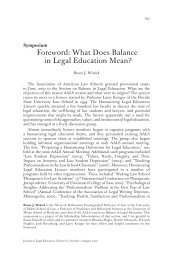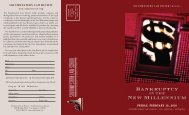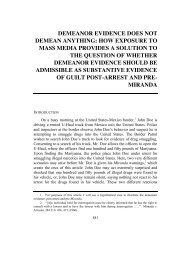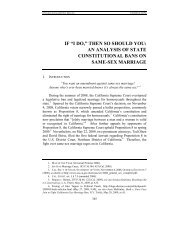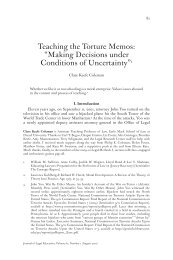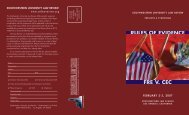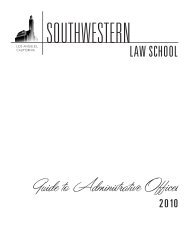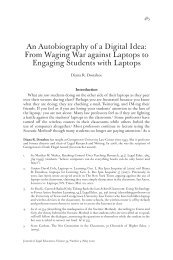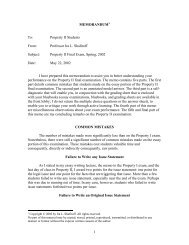What is Art? - Southwestern Law School
What is Art? - Southwestern Law School
What is Art? - Southwestern Law School
- No tags were found...
Create successful ePaper yourself
Turn your PDF publications into a flip-book with our unique Google optimized e-Paper software.
138 J. INT’L MEDIA &ENTERTAINMENT LAW VOL. 4,NO. 2worth argued the reverse; and that he had not infringed Lucasfilm’scopyrights by virtue of the acts permitted by Section 51(1) and (2).Moreover, Lucasfilm had a further leg<strong>is</strong>lative hurdle to overcome,which also depended on whether the helmets/uniforms were “art<strong>is</strong>ticworks”, and “sculptures” in particular. Section 52 of the 1988 Act providesthat where an art<strong>is</strong>tic work has been exploited (by or with thelicence of the copyright owner) through industrially producing andmarketing copies (of that art<strong>is</strong>tic work) in the United Kingdom or elsewhere,copyright in that work <strong>is</strong> effectively unenforceable 25 yearsfrom the end of the calendar year in which such articles are first marketed.In other words, Lucasfilm’s merchand<strong>is</strong>ing of miniature modelsof Star Wars characters (including the Imperial Stormtroopers andtheir armour) for 25 years (from, say, 1978 to 2003) would on theface of it mean that Ainsworth could claim h<strong>is</strong> copying and merchand<strong>is</strong>ingof the helmets from 2004 was author<strong>is</strong>ed by Section 52 of the1988 Act. However, there <strong>is</strong> one more tw<strong>is</strong>t: leg<strong>is</strong>lation supplementaryto the 1988 Act 112 provides an exception to the operation of Section 52in the case of “works of sculpture, other than casts or models used orintended to be used as models or patterns to be multiplied by any industrialprocess.” 113 Th<strong>is</strong> tw<strong>is</strong>t would operate in Lucasfilm’s favour ifits helmets/uniforms were, yet again, “sculpture” within the meaningof the 1988 Act. And so h<strong>is</strong> legal team argued.How did the UK Supreme Court determine whether the helmet wasa “sculpture” within the meaning UK copyright leg<strong>is</strong>lation? It firstconsidered previous relevant judgments of courts in England and theBrit<strong>is</strong>h Commonwealth that had determined the legal meaning of“sculpture”. A central <strong>is</strong>sue that emerged from th<strong>is</strong> review was “the relativesignificance of the functional and the art<strong>is</strong>tic”—in other words,whether or not a work was intended by the art<strong>is</strong>t to be a utilitarian object(as was contended by US Customs in the Brancusi 114 trial). Referencewas made to a landmark dec<strong>is</strong>ion by New Zealand’s Court of Appealin 1985 115 , which construed prov<strong>is</strong>ions of the Copyright Act 1962 of112. The Copyright (Industrial Process and Excluded <strong>Art</strong>icles) (No 2) Order 1989(SI 1989/1070).113. Similar special prov<strong>is</strong>ions in relation to industrially produced and marketedthree-dimensional artefacts operate in copyright laws in many other territorial jur<strong>is</strong>dictions,and are intended by leg<strong>is</strong>lators to remove such designs from the lengthy and extensiveprotection given to the “fine arts.” Although copyright protection <strong>is</strong> limitedand/or removed from such artefacts, they are usually protected—though for a farshorter period—under national and international design reg<strong>is</strong>tration laws.114. Brancusi, 54 Treas. Dec. Cust. 428 (Cust. Ct. 1928).115. Wham-O Manufacturing Co v Lincoln Industries Ltd [1985] RPC 127, [1984]1 NZLR 641.



